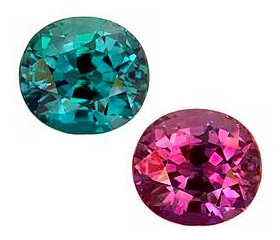
Alexandrite effect
The term alexandrite effect refers to the apparent change of color in certain minerals from blue-green or greenish violet in daylight to red or reddish violet in incandescent light. It has been determined that the absorption spectrum of all alexandrite-like minerals is characterised by transmission maxima in the blue-green and red regions and by a transmission minimum in the yellow region. The color of minerals with two such regions of transmission is determined in daylight (richer in blue and green) by the position of the transmission maxima and in incandescent light (richer in red) by the ratio of transmission in the red and transmission in the blue-violet sections of the visible spectrum.
The origin of this color change is often attributed to dichroism, but simple observation shows that the change depends chiefly on the nature of the incident light. In antiquity this change was from sunlight to candlelight and this exhibition is still used today by many gemologists and jewelers. Careful study of the color changes in chromium compounds by means of tristimulus analysis proves that the color change is due to the response of the human eye and brain and not to any unexpected changes in the properties of the stone.
As the chromium composition moves from those values which yield green compounds to those values which yield pink compounds, the interband minimum in the spectrum moves from near 525mp toward shorter wavelengths. The human eye is very sensitive to green light and is less sensitive to red and blue so it responds most strongly to the green light and the compound appears green. As the light passed by the interband minimum becomes more blue and the light passed by the long wavelength minimum becomes brighter red, the eye shifts its response from predominantly the green stimulus to a mainly red stimulus with some blue component. The gemstone now appears reddish.